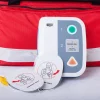
Recent Post
 Could You Recognise the Signs That Someone Needs a Defibrillator?
Could You Recognise the Signs That Someone Needs a Defibrillator?
September 12, 2023
Introduction to Blood Glucose Meter Kits
Understanding Blood Glucose
Blood glucose, often referred to as blood sugar, is derived from the food we consume. It’s transported via our bloodstream to all cells within our body, providing them with the necessary energy. Our body regulates blood glucose levels to maintain a balance – not too high or too low – which is crucial for our overall health.
Importance of Monitoring Blood Glucose
Monitoring blood glucose is vital, particularly for individuals diagnosed with diabetes. It provides an immediate snapshot of blood sugar levels, helping adjust food intake, physical activity, or medication. Regular monitoring can prevent potential health complications like heart disease, stroke, kidney damage, nerve damage, and eye problems.
What is a Blood Glucose Meter?
A blood glucose meter is a small device used to check the glucose level in the blood. It’s a quick and straightforward tool generally used by people with diabetes, either type 1 or type 2.
The Components of a Blood Glucose Meter Kit
A typical blood glucose meter kit includes the following:
- A glucose meter.
- Lancets (small needles for skin-pricking).
- Test strips (for blood placement).
- A lancing device (used with the lancet to draw blood).
Additional items may include control solutions, a carry case, and a log book.
How Blood Glucose Meter Kits Work
The Science Behind Blood Glucose Meter Kits
Most glucose meters work using a chemical reaction. The blood drop reacts with a chemical, usually glucose oxidase, present on the test strip, producing an electrical current. The meter reads this current and converts it into a blood glucose reading.
Step-by-step Use of a Blood Glucose Meter
While specific steps may vary slightly per device, the process usually involves inserting a test strip into the device, pricking your finger with the lancet, placing a small drop of blood onto the test strip, and then reading the glucose level once the meter processes it.
Reading and Interpreting the Results
The meter will display your blood glucose level on a screen. For people without diabetes, blood glucose levels generally range between 4.0 to 5.4 mmol/L (fasting), while for individuals with diabetes, a target range is usually set by the healthcare provider.
The Role of Test Strips and Lancets
Test strips are key to the process. They absorb your blood and start the chemical reaction with the glucose oxidase. Lancets are used to prick your finger to obtain the blood sample.
Types of Blood Glucose Meters
Basic Blood Glucose Meters
Basic blood glucose meters provide quick and accurate readings. They usually lack data storage, Bluetooth connectivity, or trend analysis features but are typically more affordable.
Advanced Blood Glucose Meters
Advanced meters have various features such as large screens, spoken results, illuminated test strip ports, and superior memory storage. They can also link to smartphone apps for advanced data analysis.
Continuous Glucose Monitors
Continuous Glucose Monitors (CGMs) automatically track blood glucose levels day and night. They provide real-time glucose readings, displaying trends and patterns.
Non-Invasive Glucose Meters
Non-invasive glucose meters are a developing technology. They aim to measure glucose levels without needing a finger prick, using alternate methods like analyzing sweat or scanning a light onto the skin.
Choosing the Right Blood Glucose Meter
Understanding Your Individual Needs
Choosing a meter isn’t a one-size-fits-all decision. Consider factors like your lifestyle, comfort with technology, and physical skills (such as vision and talent).
Evaluating the Features of a Glucose Meter
Consider features like the speed of results, size of the device, amount of blood needed for each reading, ability to store past results, and if it offers additional analysis.
Considering the Cost and Insurance Coverage
While considering a glucose meter, account for the ongoing cost of consumables like test strips and lancets. Insurance coverage varies significantly, so check what your plan covers.
Consulting Your Healthcare Provider
Before making a decision, discuss your options with your healthcare provider. They can offer valuable insights based on their experience and knowledge of your health history.
Accurate Use of Your Blood Glucose Meter
Preparing for a Blood Glucose Test
Before testing, wash your hands with warm water to ensure clean and ample blood flow. Make sure the meter and test strip are ready and your lancing device is correctly set up.
The Correct Technique for Using a Glucose Meter
Follow the specific instructions of your glucose meter for accurate results. Apply just enough blood to fill the specified area on the test strip. Too much or too little can result in incorrect readings.
Troubleshooting Common Issues
If you’re getting inconsistent readings, check if your meter is clean and calibrated, your strips aren’t expired, and you’ve properly washed and dried your hands before testing.
Tips to Ensure Accurate Results
Store your test strips in their original container, away from heat, moisture, and direct sunlight to ensure accurate results. Always use fresh capillary blood and avoid using the first drop of blood for testing.
This brings us halfway through our comprehensive guide. The second part will delve into maintaining your blood glucose meter, understanding your levels, the role of the meter in managing diabetes, advancements in technology, and finally, empowering yourself through blood glucose monitoring.
Maintaining Your Blood Glucose Meter
Cleaning and Storage Guidelines
Per manufacturer instructions, regular cleaning can help maintain your meter’s accuracy. Avoid exposing your meter to extreme temperatures, and store it in a cool, dry place when not in use.
When to Replace Your Meter and its Components
Generally, glucose meters have a long lifespan. However, consult your healthcare provider or the device’s manufacturer if you notice consistent inaccuracies in readings. Lancets and test strips should be replaced regularly; never use expired strips.
Regular Calibration
Some meters require regular calibration using control solutions to ensure they provide accurate readings. Always refer to your user manual to understand how often this should be done.
Safety Considerations and Disposal
Properly dispose of used lancets and test strips in designated containers. Some areas have specific disposal requirements, so be sure to check local guidelines.
Understanding Your Blood Glucose Levels
Normal Blood Glucose Levels
For people without diabetes, blood glucose levels are usually between 4.0 to 5.4 mmol/L (fasting) and up to 7.8 mmol/L 2 hours after meals. For those with diabetes, target levels are typically set with their healthcare provider.
Hypoglycaemia and Hyperglycaemia
Hypoglycaemia (low blood sugar) and hyperglycemia (high blood sugar) require immediate attention. Symptoms include dizziness, rapid heartbeat, and fatigue.
Factors Influencing Blood Glucose Levels
Various factors, including diet, physical activity, medication, stress, illness, and more, can influence blood glucose levels. Understanding these influences can help better manage your glucose levels.
Importance of Regular Check-ups
Regular medical check-ups can help detect significant changes in your glucose levels over time, allowing for adjustments in your management plan if necessary.
The Role of Blood Glucose Meter in Managing Diabetes
How Diabetes Affects Blood Glucose
In diabetes, the body’s ability to regulate insulin, the hormone that manages blood glucose, is impaired. This can lead to high blood glucose levels, making regular monitoring crucial.
Importance of Glucose Meters in Diabetes Management
Glucose meters provide immediate feedback on your blood glucose levels. This can help determine how well your diabetes management plan works and what adjustments may be needed.
Tailoring Your Diabetes Treatment Plan
A glucose meter helps tailor a diabetes management plan to your specific needs. This can include adjusting medication dosages, planning meals, or determining the best times for physical activity.
Coping with Diabetes: Support and Resources
Managing diabetes can be challenging, but you’re not alone. Numerous resources and support groups are available to help you navigate your journey with diabetes.
Advancements in Blood Glucose Monitoring Technology
Evolution of Blood Glucose Meters
Early glucose meters were cumbersome and expensive. Modern meters have improved significantly in terms of size, speed, accuracy, and affordability, and they also offer a wider range of features to suit individual needs.
Wearable Technology and Real-time Monitoring
Wearable devices, like Continuous Glucose Monitors (CGMs), provide real-time tracking of blood glucose levels, alerting users of sudden changes. These devices have revolutionized diabetes management by providing a detailed understanding of blood glucose patterns.
Integration with Smart Devices
The integration of glucose meters with smartphones and apps has made tracking, analyzing, and sharing blood glucose data easier. This can support better management and communication with healthcare providers.
Future Innovations: Towards Non-invasive Techniques
Non-invasive glucose monitoring is a promising field. Future innovations may allow monitoring without needing finger pricks or sensors, reducing discomfort and inconvenience.
Empowering Yourself through Blood Glucose Monitoring
Taking Control of Your Health
Regular monitoring of blood glucose levels can empower you to take control of your health, helping you understand how different factors influence your glucose levels and how to manage them effectively.
Using Data to Drive Decisions
Data from your glucose meter can guide decision-making about diet, physical activity, medication, and lifestyle changes. This can help optimize your diabetes management plan.
Building Confidence in Diabetes Management
Understanding your blood glucose levels can provide reassurance and confidence, allowing you to manage diabetes better and reducing the stress and uncertainty that can sometimes come with this condition.
Advocating for Your Health
Your glucose meter is a valuable tool for advocating for your health. By sharing your glucose data with your healthcare provider, you can engage in more informed and productive discussions about your treatment and management plan.
In conclusion, a blood glucose meter is a crucial tool for individuals managing diabetes. With the advancements in technology and understanding of this tool, people living with diabetes can lead healthier, more confident lives. Remember, your healthcare provider is your partner in this journey and can provide guidance tailored to your specific needs.
How Priority First Aid Helps You
Provision of Quality Blood Glucose Meter Kits
- We offer a wide range of high-quality blood glucose meter kits that meet stringent standards.
- Each product undergoes rigorous quality checks to ensure its effectiveness and reliability.
- We provide basic and advanced blood glucose meters, catering to individual needs and preferences.
Comprehensive Customer Support
- Our trained customer service team can assist with any product queries or concerns.
- We provide detailed product guides to help you understand and use your glucose meter effectively.
- Our team can also provide troubleshooting advice for common issues related to your blood glucose meter kit.
Affordable Pricing and Delivery
- We believe in providing value to our customers, hence our products are competitively priced.
- We also offer convenient and prompt delivery options to ensure you receive your blood glucose meter kit when needed.
Educative Resources
- We provide a wealth of resources to help you better understand blood glucose monitoring.
- Our guides and blog posts offer detailed information on blood glucose monitoring and diabetes management.
Continuous Innovation
- We keep up-to-date with advancements in blood glucose monitoring technology, ensuring that our product range remains at the forefront of innovation.
- We regularly update our stock to include the latest and most efficient glucose meters on the market.
At Priority First Aid, we’re committed to supporting you in managing your blood glucose levels. We aim to make the process as simple, stress-free, and effective as possible. Your health is our priority!
User Queries about Blood Glucose Meter Kits
How Often Should I Test My Blood Glucose?
Testing frequency varies based on individual needs. People with type 1 diabetes might test more frequently than those with type 2 diabetes. Consult with your healthcare provider for a personalized testing schedule.
Can I Reuse Lancets or Test Strips?
For optimal hygiene and accuracy, it’s recommended to use a new lancet and test strip for each test. Reusing lancets or test strips can lead to infection or inaccurate readings.
What Should I Do If My Reading Is Too High or Too Low?
If your blood glucose reading is significantly high or low, you should follow your healthcare provider’s recommendations. This may involve taking corrective measures such as adjusting your insulin dose or consuming glucose.
Are All Test Strips Compatible with All Meters?
No, test strips are typically designed to be used with specific meters. Using a different brand or model of the test strip may lead to inaccurate readings.
Can I Use a Blood Glucose Meter for Diagnosis of Diabetes?
A blood glucose meter can indicate high or low blood sugar levels, but it’s not a tool for diagnosing diabetes. A formal diagnosis requires specific tests conducted by healthcare professionals.
Remember, when you have any questions or concerns about your blood glucose meter or readings, your healthcare provider should be your first point of contact. They can provide advice based on their understanding of your specific health needs.






